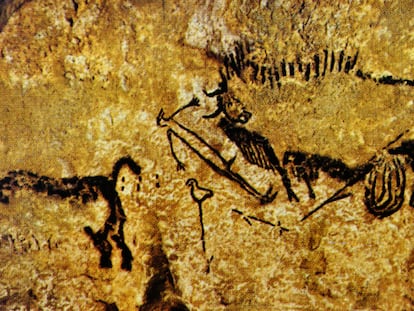Phyllida Barlow: Sculptures that use space as a material
The recently deceased British artist’s exhibit at the Chillida-Leku Museum in Spain features large-scale pieces to walk around, made with perishable materials that reflect the passage of time
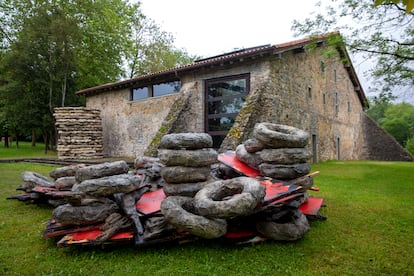
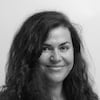
Despite their monumental shape and colossal scale, the sculptures of British artist Phyllida Barlow can be described as a flowing stream of water. A thread of liquid spills into a glass until it overflows, empties and refills with the same water, only different. Barlow was the first living artist scheduled to exhibit at the Chillida-Leku Museum in Hernani (a town in northern Spain), but died in March and didn’t live to see the opening of the exhibit on May 23. Last November, she went to the museum where she put together a project that cleverly dialogues with the work of Basque sculptor Eduardo Chillida in the 17th-century Zabalaga farmhouse on the museum grounds. The exhibit by Phyllida Barlow (on display until October 22) masterfully complements the surrounding space. The pieces fill the building like water fills a container. At times, the works of both sculptors interact and complement each other, while others stand apart like two monuments of equal significance. One notable unfinished work of Barlow is also on display along with its scale model.
Born in Newcastle upon Tyne (England) in 1944, Barlow spent most of her career teaching university art students. Some went on to become big names in the contemporary British art world, like Tacita Dean, Rachel Whiteread and Douglas Gordon. Fame came late for this sculptor who was always willing to flirt with performance art. In 2017, she represented the U.K. at the Venice Biennale art exhibition. In 2021, Barlow met Mireia Massagué, the Chillida-Leku Museum director, at a Henry Moore exhibition at the Tate Modern gallery. “In 2011, the Tate invited various artists to write about the works in its collection,” said Massagué, “and Barlow chose Modulation of Space I by Chillida… That grabbed our attention.” This opened the door to exhibiting the artist’s work for the first time in Spain.
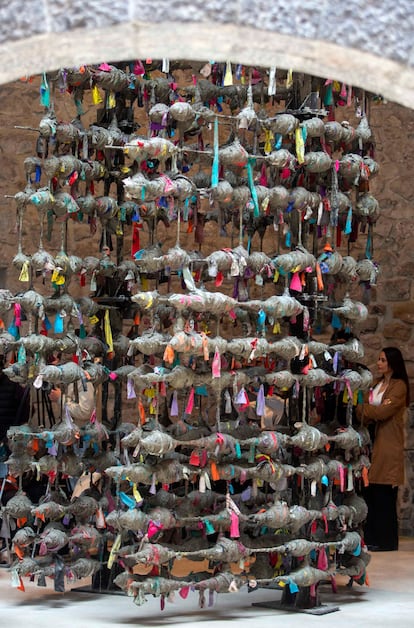
While Chillida’s sculptures represent all that is solid and stable, Barlow’s work — many of which are imposing structures — is marked by fragility and uncertainty. The large tower standing in the village center looks like an unstable skeleton, while other seemingly solid pieces are supported by hollow pedestals. The artworks culminate in their own indeterminacy, unabashedly displaying the scars of their creation. These pieces are in a perpetual state of creation that continually reveals the traces of their making. The interplay of contrasting textures invites the viewer to project their unique spatial and mental perspective — you must walk around them to perceive the nuances. Chillida found the truth of his materials in the effort, in the hand-to-hand struggle with stone, iron, and steel. Meanwhile, the British artist worked with ordinary polystyrene, clay, wood, and plaster — plebeian and perishable materials. Despite working in different mediums, both aim to shape time. One method is slow and precise, the other embraces the ephemeral nature of the present, seeking only what is pertinent for the moment.
“She would like viewers to wonder, for instance, how long someone spent tying all the knots and putting the cement in sculptures like her Untitled: tower holder, from 2020 [the 25-foot tower that spans two floors of the Zabalaga farmhouse],” said Estela Solana, the museum’s exhibit manager. “Barlow’s work is filled with concepts such as humor, the grotesque, and the juxtaposition between construction and deconstruction,” Solana added.
The pieces in every new Barlow exhibit must be reassembled and restored, becoming a different version of themselves. In order to install the tower in the Zabalaga farmhouse, the British artist’s team had to retie all the knots and coat each bulb with cement. The pieces at the building’s entrance — Untitled: holder and Untitled: fallengunstyresandplacard — are reconstructed versions of pre-existing pieces adjusted to fit the 27 acres (11 hectares) surrounding the estate Eduardo Chillida acquired in 1983.
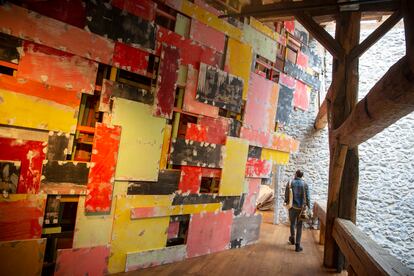
Solana says that Barlow doubted whether her work could be precisely defined as sculpture. Looking at her pieces on exhibit at the Chillida-Leku Museum, it’s easy to understand why. Untitled: folly;doublehang (2016-2017) has more of a two-dimensional quality, like a stage set, a space between the wings where viewers should not enter, but which here becomes a stage to wander, sniff around, and occupy. “Barlow uses space as a material, which is something that Chillida also does,” said Solana. “Both also play with the idea of gravity,” only Barlow used lightweight materials and Chillida heavy ones. Barlow’s drawings from 1963-2023 are exhibited in the museum’s most intimate room. Some look like finished pieces, while others look like quick sketches of future sculptures.
At the end of the tour, a distinct feeling lingers of having experienced an extraordinary artistic endeavor. Barlow’s sculptures sway in an uncertain yet alluring space, intimately blending the organic with the industrial, the solid with the soft, and the monumental with the perishable. Barlow titles all her pieces Untitled, clearly stating she isn’t keen on explaining herself. It’s up to us to give meaning to what we explored and experienced.
Sign up for our weekly newsletter to get more English-language news coverage from EL PAÍS USA Edition
Tu suscripción se está usando en otro dispositivo
¿Quieres añadir otro usuario a tu suscripción?
Si continúas leyendo en este dispositivo, no se podrá leer en el otro.
FlechaTu suscripción se está usando en otro dispositivo y solo puedes acceder a EL PAÍS desde un dispositivo a la vez.
Si quieres compartir tu cuenta, cambia tu suscripción a la modalidad Premium, así podrás añadir otro usuario. Cada uno accederá con su propia cuenta de email, lo que os permitirá personalizar vuestra experiencia en EL PAÍS.
¿Tienes una suscripción de empresa? Accede aquí para contratar más cuentas.
En el caso de no saber quién está usando tu cuenta, te recomendamos cambiar tu contraseña aquí.
Si decides continuar compartiendo tu cuenta, este mensaje se mostrará en tu dispositivo y en el de la otra persona que está usando tu cuenta de forma indefinida, afectando a tu experiencia de lectura. Puedes consultar aquí los términos y condiciones de la suscripción digital.
